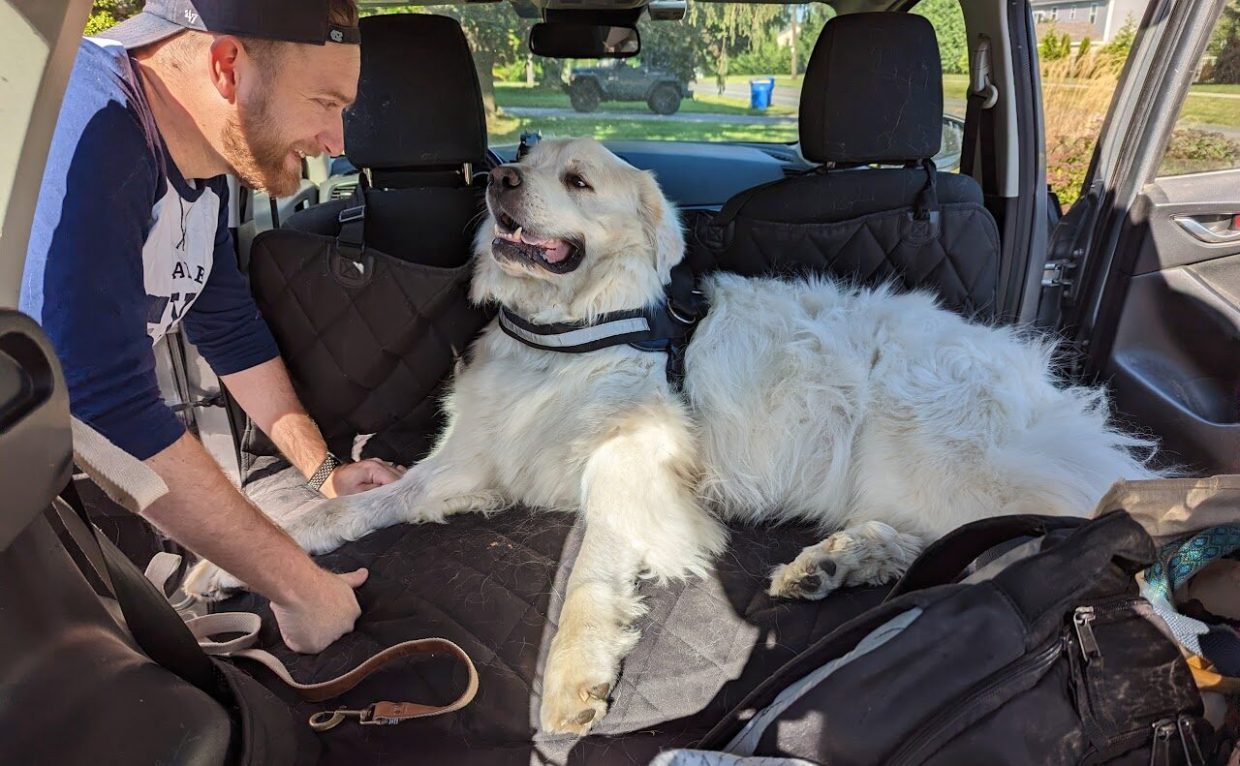
How To Keep Your Great Pyrenees Safe In The Car
As a pet owner, it’s important to consider the safety of your furry friend while traveling in a car, especially if you own a large dog breed like the Great Pyrenees. Unrestrained dogs can become projectiles in the unfortunate case of an accident, posing a danger to both the dog and to the humans in the car. Because of their size, these giant breeds can present unique challenges when it comes to car safety, but there are steps you can take to help keep your dog safe and secure.
 We had a terrible time with Blueberry coming up with a secure system, because he is such a large dog. He is 143 pounds with a chest size of 45.5 inches! Octavius, our previous Great Pyrenees, fit in the rear compartment of the vehicle, and we could keep him safe and comfortable with a simple safety leash with no problem.
We had a terrible time with Blueberry coming up with a secure system, because he is such a large dog. He is 143 pounds with a chest size of 45.5 inches! Octavius, our previous Great Pyrenees, fit in the rear compartment of the vehicle, and we could keep him safe and comfortable with a simple safety leash with no problem.
We spent weeks figuring out the best option for Blueberry (that didn’t involve buying a new car), as he didn’t fit in the rear compartment. We ended up with an XXXXL harness and a medium-length lead attaching him to a hook in the back of the car, with a seat cover that attaches to the headrests preventing him from trying to climb into the driver’s seat.
But Blueberry is on the larger end for Great Pyrenees dogs, and there are plenty of options available for even slightly smaller dogs!
Strategies for Keeping Your Dog Secure
Firstly, it’s important to make sure your Great Pyrenees is properly restrained while in the car. This can be achieved through the use of a dog seat belt or harness, which can be attached to the car’s seat belt system or secured to a car seat. The seatbelt or harness will help prevent your dog from moving around in the car and potentially causing harm to themselves or other passengers in the event of an accident.
You may need to measure your dog to find a harness that is the appropriate size. To do this, measure around their neck and around the widest part of their rib cage. Make sure you check the sizing on the harnesses as well: we only found two large enough for Blueberry, and one was out of stock!
Keep in mind that the larger sizes of harness may cost more than the smaller sizes. Harnesses and dog seat belts can be found at most pet stores, such as Petco and Chewy, as well as on Amazon.
Another option for car safety is to use a dog crate. This can provide a secure and comfortable space for your Great Pyrenees while traveling in the car. The crate should be large enough for your dog to stand up, turn around, and lie down comfortably, but not so large that they are at risk of being thrown around in the event of an accident. Because Pyrs are such large animals, this is not an option that will work for everyone. But if you have a large enough vehicle for an XL size dog crate, this may be the best solution for safety. Be sure that the crate is secured to the car as well, so it doesn’t become a projectile in the case of an accident.
It’s also important to consider the temperature inside the car. Great Pyrenees have thick coats that can make them prone to overheating, so it’s important to make sure the temperature inside the car is comfortable for them. Avoid leaving your dog in the car for extended periods of time, especially in hot weather. If you must leave them in the car, make sure the windows are cracked open and there is plenty of ventilation; and if possible, leave the car running with the air conditioning on.
In addition to these safety measures, it’s important to prepare your Great Pyrenees for car travel by acclimating them to the car and providing them with plenty of positive reinforcement. Take short trips with your dog in the car and gradually increase the length of the trips over time. Offer your dog treats and praise for good behavior in the car to help them associate car travel with positive experiences.
Finally, consider purchasing a bumper sticker that alerts other drivers that a dog may be in the car–especially if you keep your dog in the rear of the vehicle. Many drivers tailgate, and while you can’t control their behavior, you may be able to reduce the chance of a fender bender injuring your pet, simply by reminding other drivers that reckless driving can endanger an animal. In addition, practice safe driving techniques when your dog is in the car, such as keeping a buffer zone between you and other vehicles, matching your speed with traffic, making sure your brake lights are working, and using your blinkers to more effectively communicate with other drivers.
We have safely driven both Octavius, our previous dog, and Blueberry distances everywhere from a few miles, to hundreds of miles. Blueberry’s favorite word is “car,” in fact. He doesn’t even care if he gets out at our destination, as long as he gets to come along with us.
Car safety is an important consideration for pet owners, especially for those who own large dog breeds like the Great Pyrenees. Proper restraint, temperature control, and utilizing safe driving practices can help you keep your dog safe and secure while traveling in the car. By taking these precautions, you can help ensure that your furry friend stays safe and happy on the road.

